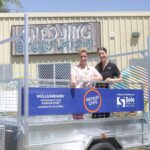Solo Resource Recovery’s IVECO Stralis model

When the Swiss Army knife was introduced in the 1880s, it was made for soldiers that needed a foldable tool to open canned food and allow their rifle to be disassembled. More than a century later, it has been adapted with even greater versatility to perform several tasks with a single tool. As businesses seek to increase their efficiencies, the same idea of using one product to perform multiple tasks applies to many industries, including waste. Solo Resource Recovery is a major player in Australia’s waste industry, namely along the country’s eastern seaboard where it has provided waste solutions for government, business and households for more than 80 years. Solo specialises in the collection, transport, processing and disposal of all types of waste from household to commercial, industrial, medical and hazardous, along with organics waste and recyclables. The company also manufactures a range of its own waste bodies, putting its decades of industry experience into practice.
More recently, Solo expanded into the Western Australian market, and rather than putting all of its faith into a single service, the company introduced a vehicle that could provide a number of waste collection options. Dave Hancock, Solo Resource Recovery National Fleet Manager, says the company’s foray into Western Australia had thrown up some challenges. “It can be a tough ask entering any new market, but setting up in WA from the other side of the country made things more difficult. Our entry also coincided with a slowdown in the mining sector, which resulted in a lot of the players coming back into the towns so competition was strong,” Dave explains. Solo Resource Recovery has been heavily using IVECO trucks for decades, starting off with ACCOs and more recently adding Stralis models to its fleet. “We started with a small fleet in WA and also chose vehicles and body configurations that would provide us with added flexibility – our IVECO Stralis is a good example of this,” Dave says.
Solo Waste’s Stralis 8×4 vacuum truck features a 10,000-litre tank mounted on a hooklift frame and also hauls a quad axle dog trailer fitted with a 15,000-litre tank. The truck is kept busy six days per week working on a range of commercial and industrial projects along with wharf collection. Depending on the job at hand, the vehicle will either operate as a truck only or with the dog trailer as well. According to Dave, a closer look behind the Stralis’ cabin sees a hook and tarp, which also allows the truck to be used for hooklift bin work. He says changing the bodies is a fast and straight-forward exercise. “A five-minute changeover might be cutting it a little fine, but it shouldn’t take too much longer than that,” Dave says. “The tanker body has some quick release couplings and then it’s just a case of disengaging a few hoses and sliding the body off.
It’s as simple as that. “Coming into the WA market, it was ideal that we could cover off a couple of different types of waste collection with a single truck and this vehicle has allowed us to do this, admittedly though its working life to date has mainly been as a vacuum truck.” This Stralis is powered by a Cursor 13 engine producing 500 horse power and 2300 newton metres of torque from a low 1000 revolutions per minute. The engine is matched to the Eurotronic 16-speed automated transmission while smoothing out the bumps is front and rear airbag suspension. Dave says that the Stralis is performing well and is popular with the driver. “The Stralis works hard and is often operating near its maximum weight. Some days it can travel up to 600 kilometres and, once on a job site, is idling for extended time at 1000 revolutions per minute while the pump is operating – everything runs off the engine,” Dave says. “I’m impressed with the fuel efficiency, despite the weight and idle times it’s still returning figures of around 19.4 litres per hour.
That’s pretty good going. “For this truck we normally use one driver, given that it’s dangerous liquids registered. He has the extra training needed to drive and operate the vehicle. “He enjoys driving it. It’s a comfortable work environment and does the job exactly as it should.” Given Solo Resource Recovery’s sizeable investment in the truck and body, it will remain on fleet for around 10 years. It’s also regularly serviced and maintained to ensure this longevity. Dave says that maintenance responsibilities are shared between the company’s in-house mechanic and IVECO Dealership AV Trucks. “We have our own workshop but still being early days in the operation we only have one full time mechanic at this stage,” Dave says. “He’s kept pretty busy working on our fleet of 17 units, so we also call on the local IVECO dealership to help out. The arrangement works well for us.” Credit and thanks to Waste Management Review for this recent article on Solo Resource Recovery
Related Posts

Published: October 1, 2024
Is Your Waste Management Performance Up to Scratch? Discover the Solo Difference
Read more
Published: August 15, 2024
Solo Invests in the Future: Company Expands Fleet with Hydrogen Vehicles
Read more
Published: December 15, 2023